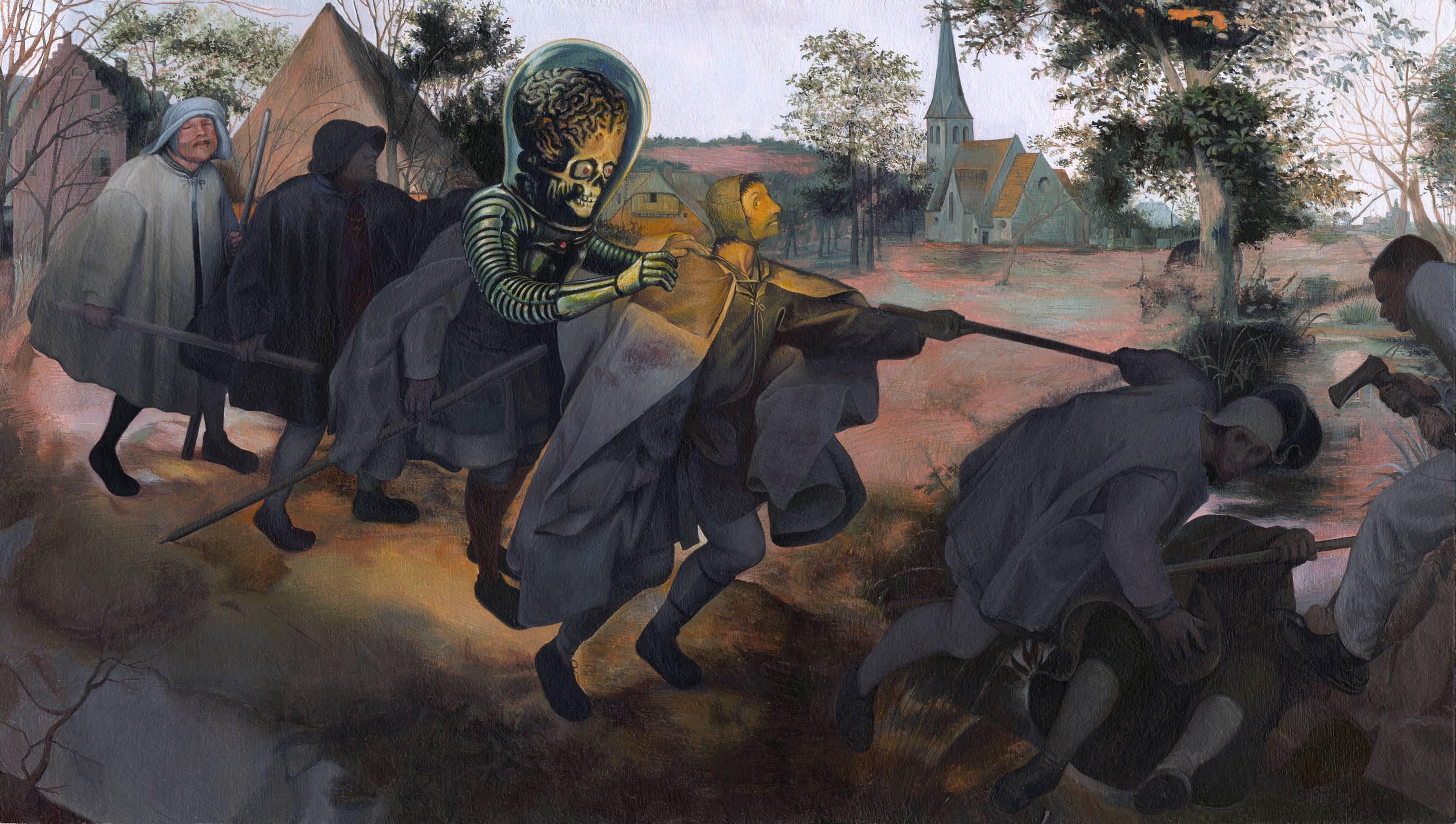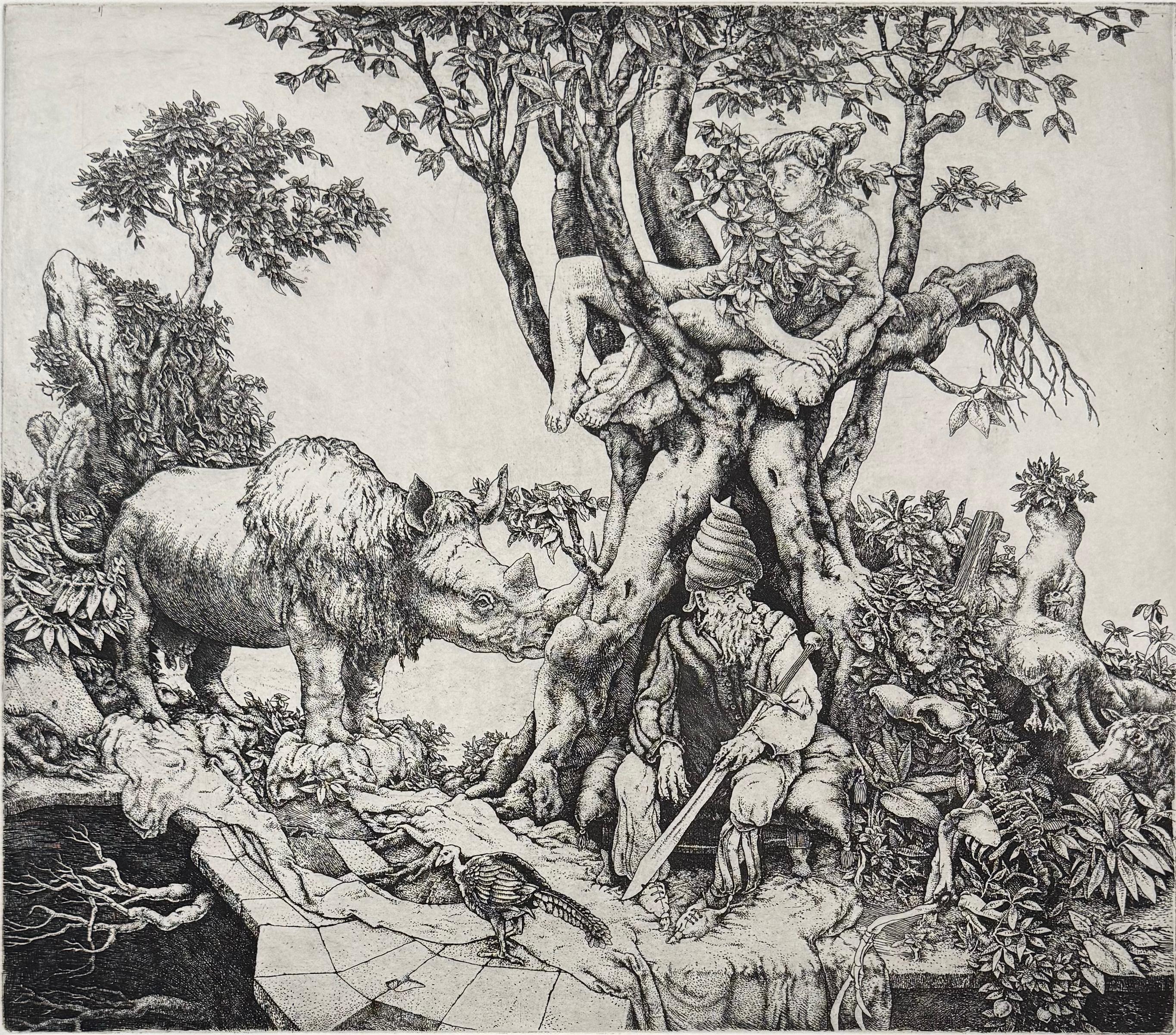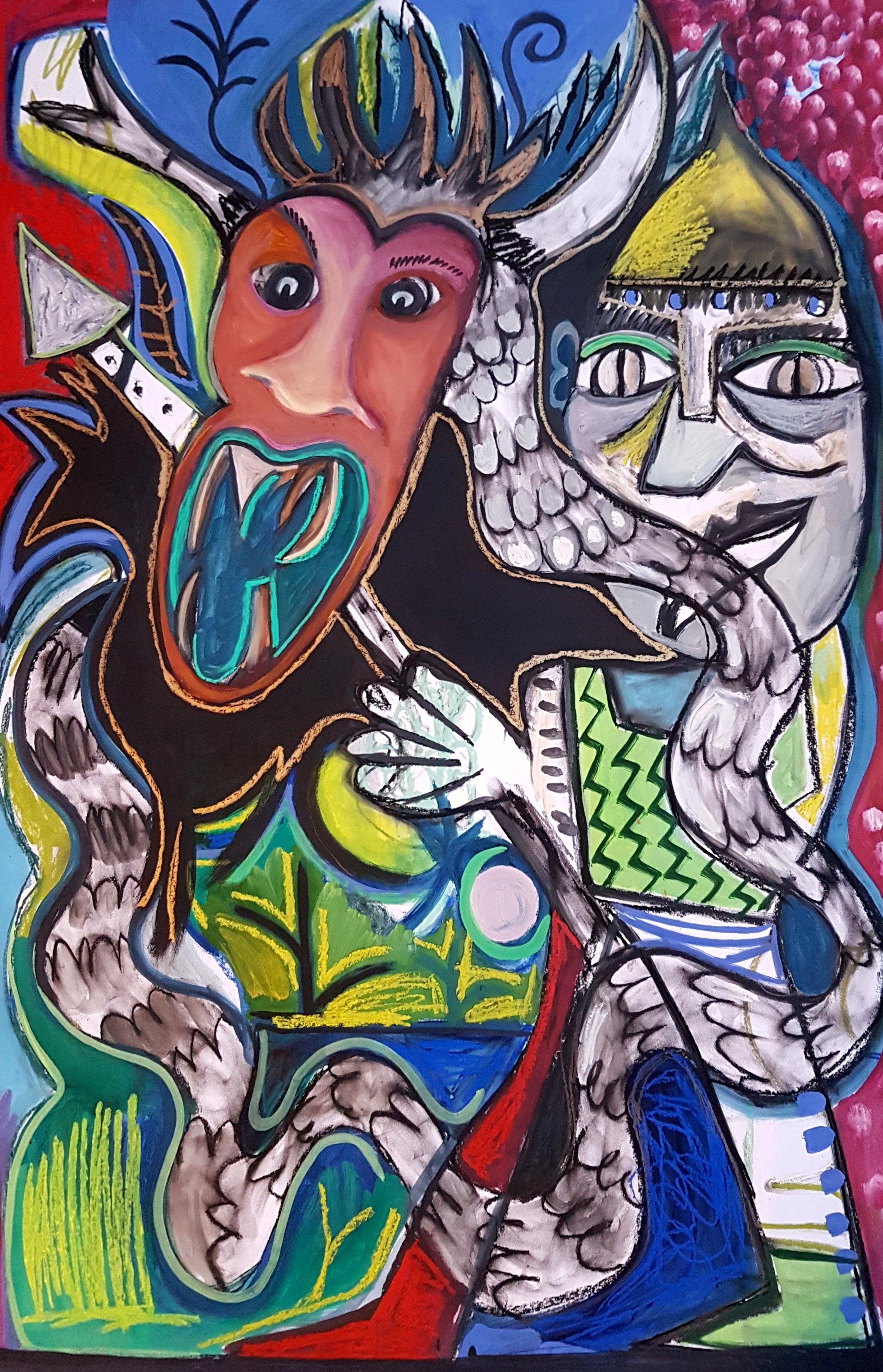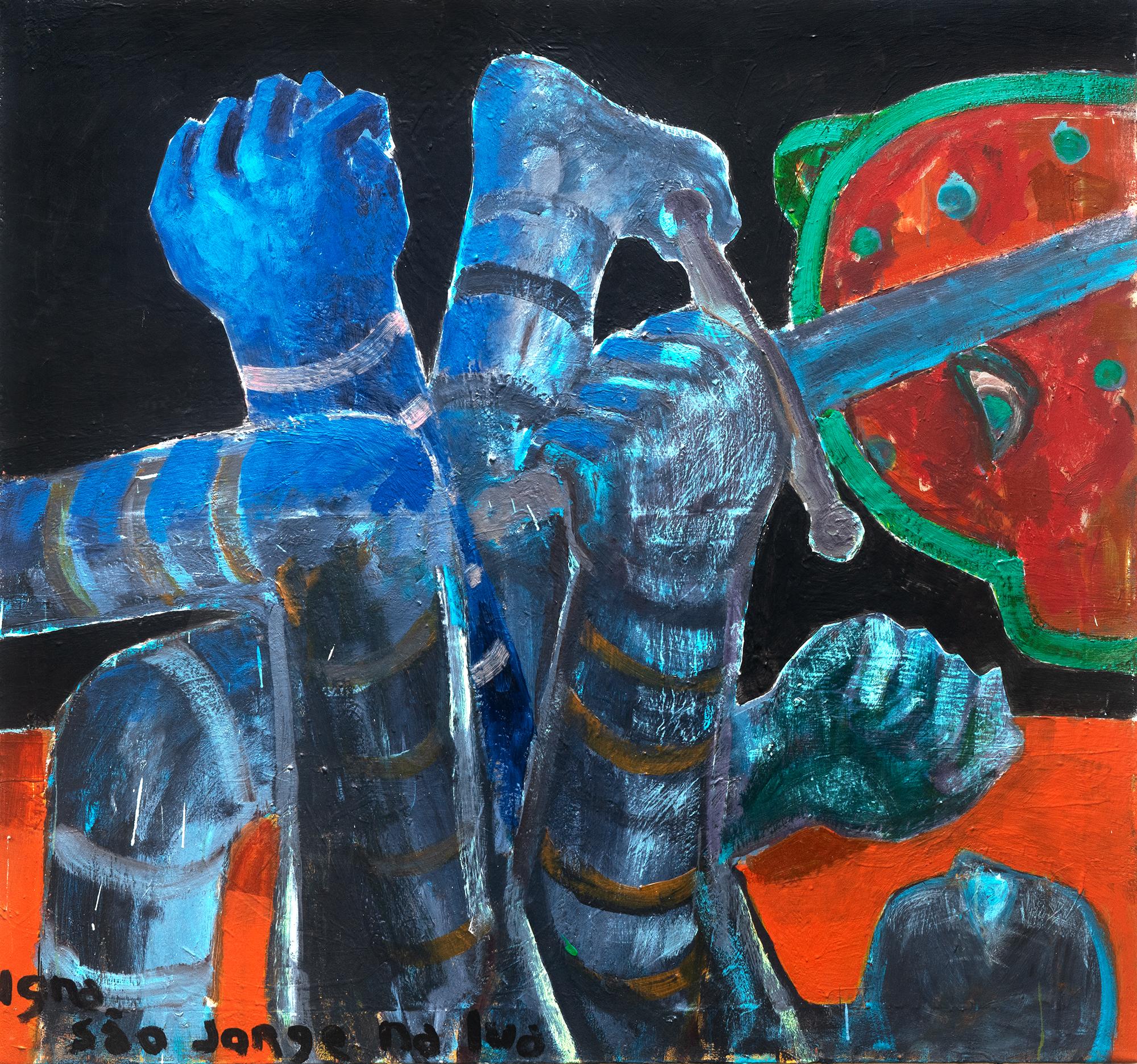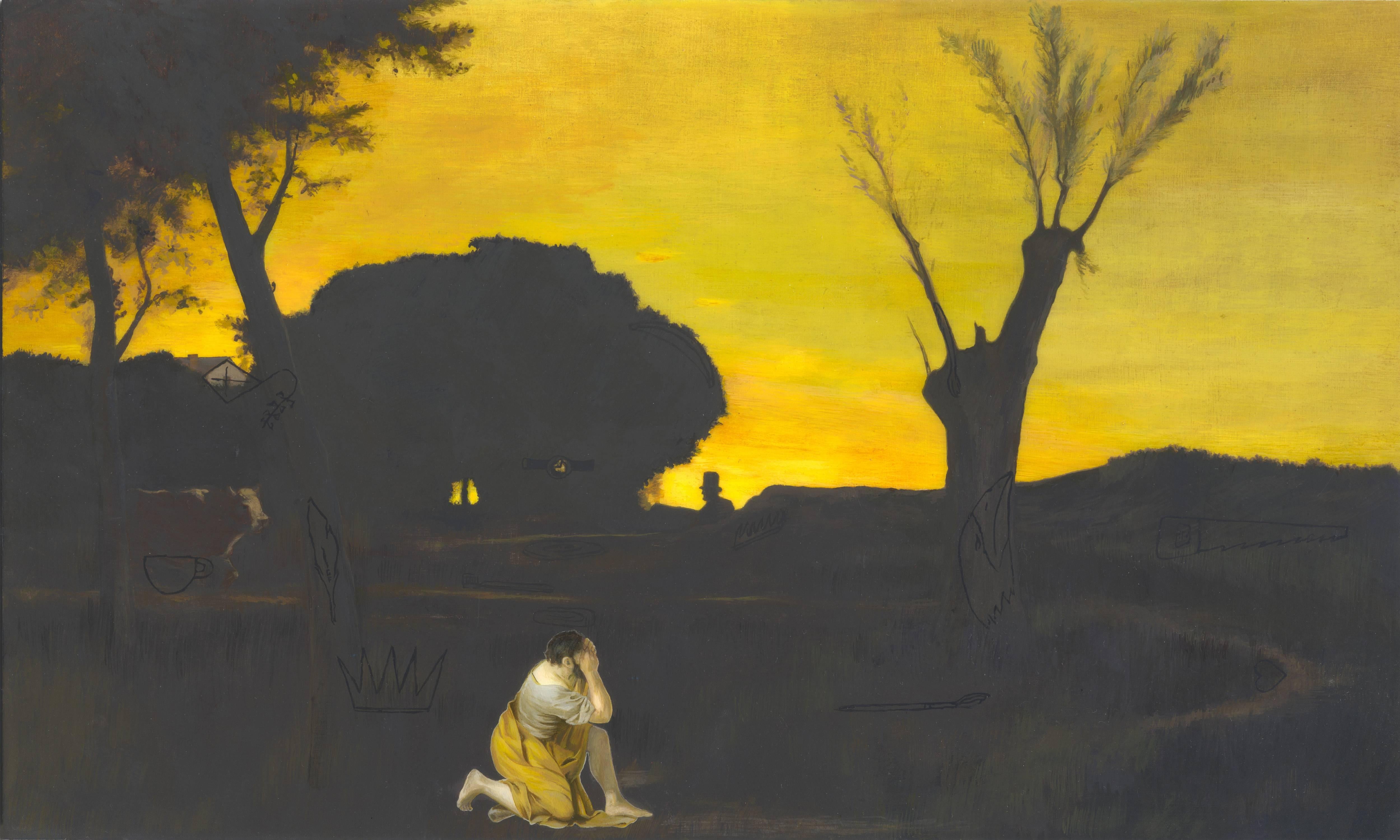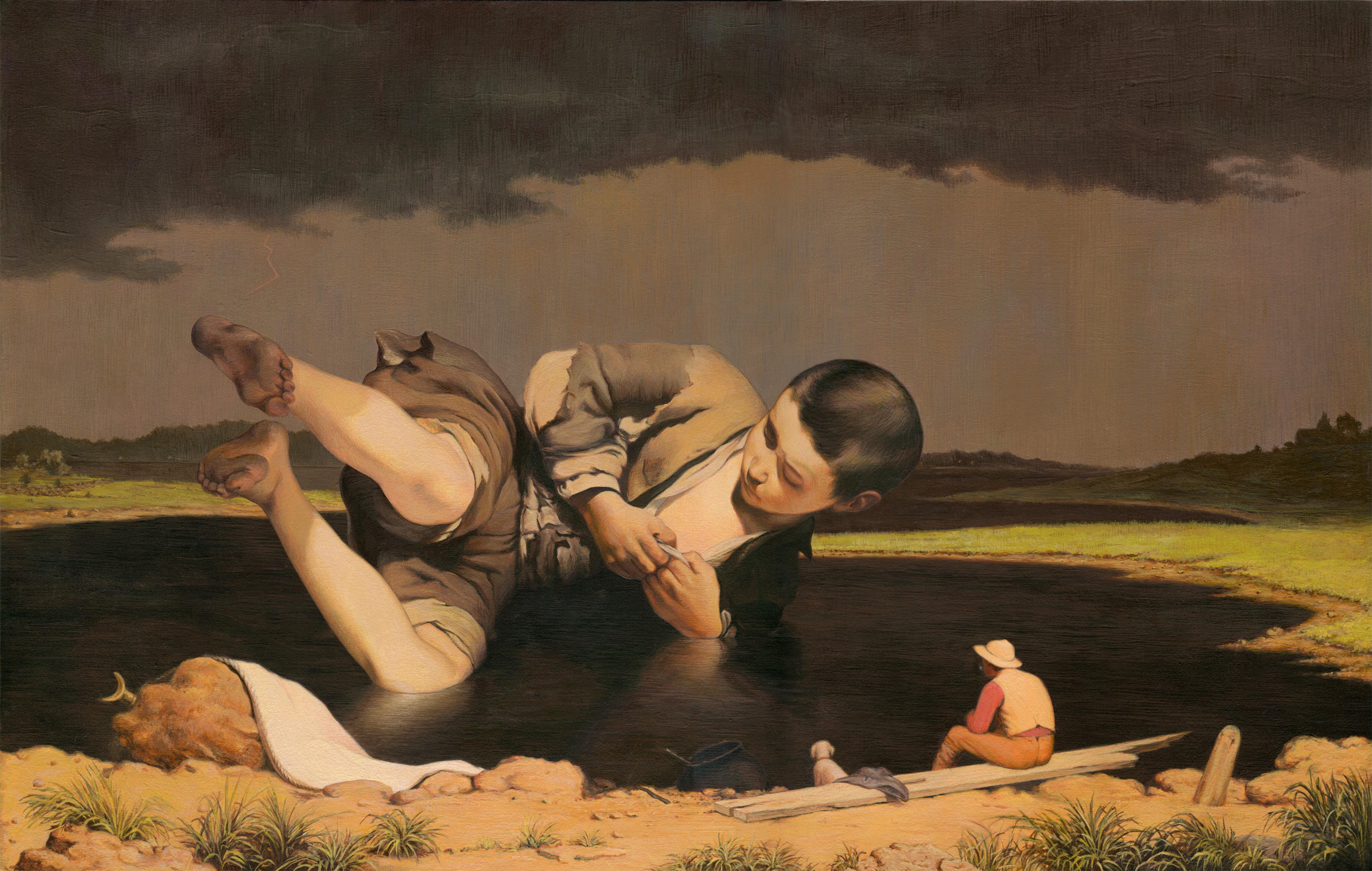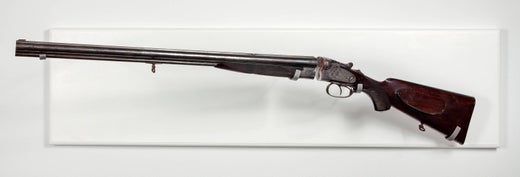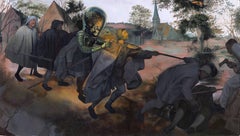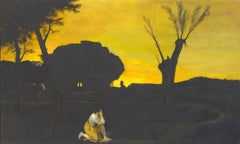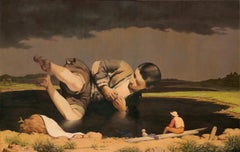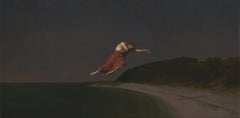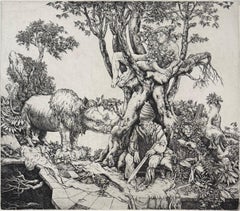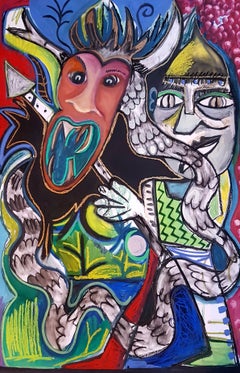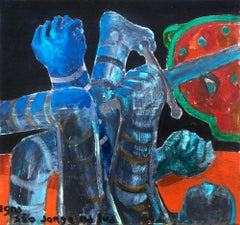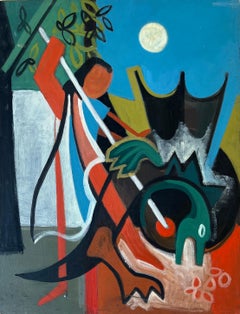Items Similar to Having Found the Lowest Threshold (St. George Slaying the Dragon)
Want more images or videos?
Request additional images or videos from the seller
1 of 2
Adam MysockHaving Found the Lowest Threshold (St. George Slaying the Dragon)2013
2013
$14,300
£11,108.65
€12,604.48
CA$20,446.29
A$22,368.75
CHF 11,682.77
MX$267,312.09
NOK 146,778.13
SEK 138,141.40
DKK 94,128.27
About the Item
After: Nicolas Poussin’s Massacre of the Innocents, from 1629
Framed: 8.50h x 9.50w in
In the summer of 2013, the murder of Trayvon Martin dominated weeks of news cycles. As if we needed more of such news, the city of New Orleans had its own slate of what I referred to as “murdered minors.” The whole phenomenon reminded me of the biblical Massacre of the Innocents, the story in which Herod orders the execution of all young males in Bethlehem to avoid the loss of his throne to a newborn king. I began questioning what justification could possibly defend these modern slayings, and it quickly dawned on me that it never seemed to take much for the killers to justify their actions. Sometimes it was a simple as the victim wearing the wrong kind of clothing.
Nicolas Poussin’s The Massacre of the Innocents has always been my favorite depiction of the aforementioned biblical tale, but much like the killing of youths that seemed to characterize that summer, it had never been a settled image for me. I decided to experiment with it, to see what changes I had to compel in order for the actions depicted to feel reasonable.
Having Found the Lowest Threshold (St. George Slaying the Dragon) was the result.
The women and children had to be from another world—they had to be aggressive—in order for the soldier’s actions to feel “okay.” Sadly, those two criteria could be met simple by giving them another skin color and a different vision than the one holding the weapon.
ABOUT THE ARTIST
Adam Mysock was born in Cincinnati, Ohio in 1983 - the son of an elementary school English teacher and a lab technician who specializes in the manufacturing of pigments. On account of a steady stream of folk tales from his mother, his father's vividly dyed work clothes, and a solid Midwestern work ethic, he developed an interest in painting and drawing all things Americana from a very early age. Mysock earned a Bachelor of Fine Arts degree in Painting and Art History by 2004 from Tulane University. He then received an MFA from Southern Illinois University at Carbondale.
After his studies, he became the mural coordinator for the City of Cincinnati's MuralWorks mural program and worked as an adjunct drawing professor at Sinclair Community College in Dayton. In the summer of 2008, Mysock became a Professor of Practice at Tulane University where he currently teaches and maintains a studio. Mysock's work has been exhibited in Ohio, Kentucky, Illinois, Georgia, Mississippi and Louisiana and is in private collections across the US, including those of Thomas Coleman and Michael Wilkinson. He was a 2009 jury winner in the annual No Dead Artists juried exhibition. On August 4th, 2012 he was awarded first prize “Best in Show” in the Ogden Museum’s Louisiana Contemporary Annual Juried Exhibition. Mysock exhibited at Pulse Miami Art Fair in December 2012 with Jonathan Ferrara Gallery and he was selected for the 2013 Edition of New American Paintings. Mysock was exhibited in a solo project booth at the VOLTA9 Art Fair in Basel, Switzerland where he was acquired by the SØR Rusche Collection. In 2015, Mysock’s work will be featured in a Baroque and Contemporary group exhibition from the SØR Rusche Collection, Oelde/Berlin at Kunsthalle Jesuitenkirche as well as in a solo exhibition entitled When Everything Was Wonderful Tomorrow at Galerie Andreas Binder in Munich, Germany.
I’m a revisionist history painter. Rather than rewrite the narrative of the past to justify an ideology, I repaint yesterday’s imagery in order to rationalize our present circumstances.
Mysock says of his work, “Telling stories is a part of human nature; it’s how we relate to one another. The stories we have in common help us create sincere connections to our neighbors and our surroundings. What’s more, storytelling – for better or worse – typically involves hyperbole. We tend to exaggerate; we tend to lie.
Generally, we believe we control our narrative embellishments. What gets exaggerated from one telling to another gets exaggerated to challenge our listeners. What gets repeated gets repeated because it resonates with them. What gets omitted gets left out because it’s lost its meaning. We actively use embellishment to keep our audiences engaged.
Given enough distance, however, sources and accuracy fade out and substitutions become the new norms. Quietly, time redefines what is truth and what is fiction.
As a painter, I’m preoccupied by the undeniable role that the image plays in creating this acceptance of the fictional. A painting has the authority to make the intangible concrete, and a series of them has the ability to authenticate a fabrication in our collective memory.
When I begin a piece, I typically start with preexisting images, artifacts from this collective remembrance. I look for images that shape my pictorial consciousness, that are hard to question because when I first saw them they were presented as the truth. They have to capture my imagination and they have to feel largely descriptive of a greater story. From them, I’m given my task – I have to “disrepair” them. I have to consolidate an earlier world of historical and cultural visual-fact with an evolving understanding of subtlety and gradation. I find that the discrepancies I discover between the absolute and the nuanced inspire me most.
The resultant work is largely about storytelling, the ownership and authorship of our culture’s visual narratives, and the parallels between those tales. It’s meant to challenge the truth of “source” and the source of truth. After all, as Franz Kafka once wrote, "It is hard to tell the truth, for although there 'is' one, it is alive and constantly changes its face."
statement
"In the summer of 2013, the murder of Trayvon Martin dominated weeks of news cycles. As if we needed more of such news, the city of New Orleans had its own slate of what I referred to as “murdered minors.” The whole phenomenon reminded me of the biblical Massacre of the Innocents, the story in which Herod orders the execution of all young males in Bethlehem to avoid the loss of his throne to a newborn king. I began questioning what justification could possibly defend these modern slayings, and it quickly dawned on me that it never seemed to take much for the killers to justify their actions. Sometimes it was a simple as the victim wearing the wrong kind of clothing.
Nicolas Poussin’s The Massacre of the Innocents has always been my favorite depiction of the aforementioned biblical tale, but much like the killing of youths that seemed to characterize that summer, it had never been a settled image for me. I decided to experiment with it, to see what changes I had to compel in order for the actions depicted to feel reasonable.
Having Found the Lowest Threshold (St. George Slaying the Dragon) was the result.
The women and children had to be from another world—they had to be aggressive—in order for the soldier’s actions to feel “okay.” Sadly, those two criteria could be met simple by giving them another skin color and a different vision than the one holding the weapon."
- Creator:Adam Mysock (1983, American)
- Creation Year:2013
- Dimensions:Height: 6 in (15.24 cm)Width: 7 in (17.78 cm)
- Medium:
- Movement & Style:
- Period:
- Condition:
- Gallery Location:New Orleans, LA
- Reference Number:1stDibs: LU1052469112
Adam Mysock
Adam Mysock holds a BFA degree in Painting and Art History from Tulane University and an MFA from Southern Illinois University at Carbondale. In collaboration with his studio practice, he has taught at the university level for more than 10 years, most recently as a Senior Professor of Practice at Tulane University in New Orleans, Louisiana.
About the Seller
5.0
Platinum Seller
Premium sellers with a 4.7+ rating and 24-hour response times
Established in 1998
1stDibs seller since 2015
178 sales on 1stDibs
Typical response time: <1 hour
- ShippingRetrieving quote...Shipping from: New Orleans, LA
- Return Policy
More From This Seller
View AllReal and Imagined
By Adam Mysock
Located in New Orleans, LA
after: Pieter Bruegel the Elder’s The Blind Leading the Blind (1568), Akseli Gallen-Kallela’s Building (1903), and #17 Beast and the Beauty from Wally Wood’s, Bob Powell’s, and Norm Saunders’ Mars Attacks trading cards...
Category
2010s Contemporary Figurative Paintings
Materials
Acrylic, Panel
And Abram fell on his face: and God talked with him
By Adam Mysock
Located in New Orleans, LA
“Moses and the Burning Bush” by Sébastien Bourdon (1642-45) and “Evening at Medfield, Massachusetts” by George Inness (1875)
Framed: 12h x 18.50w in
This image begins with two allus...
Category
21st Century and Contemporary Contemporary Paintings
Materials
Acrylic, Panel
A Surmountable Problem Writ Large
By Adam Mysock
Located in New Orleans, LA
After: The Young Beggar by Bartolomé Esteban Murillo (c. 1645-50) and Approaching Thunder Storm by Martin Johnson Heade (1859)
The main character of this painting finds himself mired in a pond as a sizeable storm approaches, and yet – instead of standing up and removing himself from the trouble – he chooses to focus on the discomfort of his wet clothing.
This child, attending to a minor nuisance rather than enacting a permanent solution, stands in as an icon of our current sociopolitical leadership – leadership which has defined our modern reality by its preference for constantly kicking the can on major issues (climate change, income inequality, various forms of discrimination, and so much more) as the rest of us are left to watch from the shore.
ADAM MYSOCK was born in Cincinnati, Ohio in 1983 - the son of an elementary school English teacher and a lab technician who specialized in the manufacturing of pigments. On account of a steady stream of folk tales from his mother and his father’s vividly dyed work clothes, he developed an interest in narrative and representative painting from an early age. Mysock earned a Bachelor of Fine Arts degree in Painting and Art History in 2004 from Tulane University and an MFA from Southern Illinois University at Carbondale in 2007.
After his studies, Mysock taught at the university level for nearly a decade, including as a Professor of Practice at Tulane University. In 2016, he and his family moved back to Cincinnati, where he currently serves as coordinator for Manifest Drawing Center.
Mysock’s work has been exhibited throughout the country and is in private collections across the US, including the 21c Museum, Beth Rudin DeWoody, Ruslan Yusupov, Thomas Coleman and Michael...
Category
21st Century and Contemporary Contemporary Figurative Paintings
Materials
Acrylic, Panel
Having Missed the Mark with Our Grief
By Adam Mysock
Located in New Orleans, LA
After: The Death of Seneca by Manuel Domínguez Sánchez (1871) and Eaton's Neck, Long Island by John Frederick Kensett (1872)
Painted as a response to the ongoing conversations about race and policing in the United States in 2020, Having Missed the Mark with Our Grief focuses on the problem of the “But what about…” conversations that too often accompany discussions about systemic racism and discrimination. From the nonsensical All Lives Matter crowd to the virtue-signaling of more well-meaning, empathetic groups, people outside of BIPOC communities too frequently seem ready to misdirect valuable attention away from meaningful change toward their own unthreatened subcultures.
Having Missed the Mark with Our Grief presents a mourning white male pulled from The Death of Seneca hovering above the shore of Eaton’s Neck, far from an “X” drawn in the sand. The setting is simple and uncomplicated beyond the target on its shore. However, the forlorn figure draws the spotlight away from the marked terrain toward his dramatic presentation of suffering.
ADAM MYSOCK was born in Cincinnati, Ohio in 1983 - the son of an elementary school English teacher and a lab technician who specialized in the manufacturing of pigments. On account of a steady stream of folk tales from his mother and his father’s vividly dyed work clothes, he developed an interest in narrative and representative painting from an early age. Mysock earned a Bachelor of Fine Arts degree in Painting and Art History in 2004 from Tulane University and an MFA from Southern Illinois University at Carbondale in 2007.
After his studies, Mysock taught at the university level for nearly a decade, including as a Professor of Practice at Tulane University. In 2016, he and his family moved back to Cincinnati, where he currently serves as coordinator for Manifest Drawing Center.
Mysock’s work has been exhibited throughout the country and is in private collections across the US, including the 21c Museum, Beth Rudin DeWoody, Ruslan Yusupov, Thomas Coleman and Michael...
Category
21st Century and Contemporary Contemporary Figurative Paintings
Materials
Acrylic, Panel
And the LORD said unto Abram...
By Adam Mysock
Located in New Orleans, LA
Full title: "And the LORD said unto Abram, after that Lot was separated from him, 'Lift up now thine eyes, and look from the place where thou art northward, and southward, and eastward, and westward'"
After: “In the Fields” by Eastman Johnson (1880) and “The Sacrifice of Moses” by Massimo Stanzione (1629)
Framed: 12h x 17.50w in
This piece is about redirection. While inserting Lincoln into Eastman Johnson’s In the Fields, it became quite apparent that emulating Johnson’s paint handling would make it quite difficult to capture a likeness. I needed to clarify Lincoln’s face in order to give him an identity. To overcome the obvious stylistic discrepancies, bizarre elements of Massimo Stanzione’s The Sacrifice of Moses were inserted to pull attention right, most specifically the pointing Moses. Baseball player Pat Burrell (of the 2010 World Series Champion San Francisco Giants...
Category
21st Century and Contemporary Contemporary Paintings
Materials
Acrylic, Panel
A Brush With Justice
By Adam Mysock
Located in New Orleans, LA
From Nicholas Poussin’s The Death of Sapphira, circa 1652
Sooner or later, we get caught lying. For most of us, it’s incredibly early in life, and the falsehood detected is innocuou...
Category
21st Century and Contemporary Contemporary Figurative Paintings
Materials
Varnish, Acrylic, Wood Panel
You May Also Like
The Dotage of St. George , by Stan Washburn
By Stan Washburn 1
Located in Palm Springs, CA
A view of St. George living at peace with the animals around him. While Washburn's techniques bear favorable comparison with the old masters, there is a definite modern sense of wit ...
Category
1970s Contemporary Landscape Prints
Materials
Etching
St Georges fighting the dragon -Timothy Archer, 21st Century paint, Figurative
By Timothy Archer
Located in Paris, FR
Oil paint, pastel and charcoal on paper
Signed and dated by the artist
Category
2010s Contemporary Figurative Paintings
Materials
Paper, Charcoal, Oil Pastel, Oil
St. George, Painting. From the Series Figures
Located in Miami Beach, FL
"For Jose Ignacio Suarez an abyss of time and space distances him from those who were the first inhabitants of the Brazilian coasts and of this vast American continent. His initial l...
Category
2010s Abstract Abstract Paintings
Materials
Canvas, Acrylic
Saint Michel Slaying the Dragon
Located in Genève, GE
Work on wood
Direct from the artist's studio
Category
Mid-20th Century Animal Paintings
Materials
Oil
The Great Sword Fight
By Macauley Norman
Located in Jersey City, NJ
Oil, acrylic, and mixed media on canvas
Category
2010s Contemporary Figurative Paintings
Materials
Canvas, Mixed Media, Oil, Acrylic
Neoclassical, renaissance, Biblical, St Sebastian "Martyrdom" (After Guido Reni)
By Giancarlo Impiglia
Located in Bridgehampton, NY
Part of Giancarlo Impiglia's iconic "camouflage" series in which, deviating from his signature style, he expresses his classical education, flawless technique, and concerns about the...
Category
2010s Figurative Paintings
Materials
Canvas, Oil
More Ways To Browse
George Dragon
St George And The Dragon
George Founds
Nicolas Poussin
St George Art
Michael Wilkinson
St Michael And The Dragon
Massacre Of The Innocents
Autumn Landscape 20th Century Oil
Bay Area Figurative
Corporate Art
Greece Paintings
Impressionist Forest
Midcentury Boat Painting
1924 Paintings
Fishing Boat Paintings
Royal Academy Summer Exhibition
Colorado Painting
